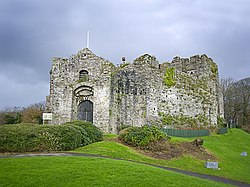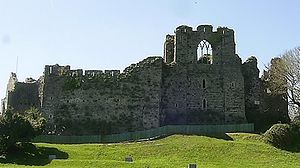Oystermouth Castle
| Oystermouth Castle Welsh: Castell Ystum Llwynarth | |
|
Glamorgan | |
|---|---|
 Oystermouth Castle | |
| Location | |
| Grid reference: | SS613883 |
| Location: | 51°34’35"N, 4°0’11"W |
| Village: | Oystermouth |
| History | |
| Built 12th Century | |
| Information | |
| Condition: | Ruin |
| Owned by: | Swansea Council |
Oystermouth Castle is a Norman stone castle in Oystermouth in Glamorgan, overlooking Swansea Bay on the east side of the Gower Peninsula.
The early castle
The first castle was founded by William de Londres of Ogmore Castle soon after 1106 following the capture of Gower by the Normans. In 1116 the Welsh prince of Deheubarth retook Gower and forced William to flee his castle which was put to the torch. The castle was rebuilt soon afterwards, but was probably destroyed again in 1137 when Gower was once more retaken by the princes of Deheubarth. The Londres or London family finally died out in 1215 when Gower was again taken by the Welsh under the leadership of Llywelyn the Great. In 1220 the Welsh princes were expelled from the peninsula and the government of King Henry III returned the barony of Gower to John de Braose who rebuilt both Swansea Castle and Oystermouth.
In de Braose hands
In the 13th century the Braose family were Lords of Gower and held the castle as part of their extensive land holdings and titles, including other castles on Gower and in the Welsh Marches. The de Braose dynasty could afford to rebuild Oystermouth castle in stone. A high curtain wall was built, internal buildings added, a chapel, basements, three storey residential buildings with fireplaces and garderobes on each floor. The castle had every residential feature necessary for living in some comfort and was also refortified cleverly. Towards the end of the century Oystermouth rather than Swansea Castle became their principal residence. King Edward I paid a brief visit here in December 1284.
By 1331 the Lords of Gower were living elsewhere and the castle declined in importance in the 14th century.
Aline de Breos, the daughter of William de Braose, the last de Breos Lord, improved the chapel making it one of the finest in any castle in south Wales. She later married John de Mowbray, and the Lordship of Gower including the castle at Oystermouth passed to the de Mowbrays through this marriage, and then to the Herbert family, and finally the Somersets, who became successive Marquis of Worcester and finally Dukes of Beaufort.
Decline and decay
After the Middle Ages, the castle gradually fell into ruin. A survey of Gower made in 1650 describes Oystermouth Castle as [a]n old decayed castle of no use, but of a very pleasant situation. It was portrayed in art in the 18th century as a picturesque ruin, and was restored by George Grant Francis in the 1840s while the castle was owned by the then Duke of Beaufort.
In 1927 the Duke of Beaufort gave the castle to Swansea Corporation.
Notable features of the castle

On either side of the entrance gate the walls curve inward, showing that at one time there were supposed to be two round towers built into the gatehouse. It is unknown whether these were ever built.
The chapel (on the second floor of the chapel block) has 14th century traceried windows. According to local tradition the chapel was built under the direction of Aline de Mowbray.
Remnants of an ornate mediæval painting dating back to the 14th century have recently been found in the chapel. The surviving painting is thought to be over 700 years old and was spotted during conservation work in the historic attraction's chapel area. Exposure to the elements has taken its toll on the painting over time but expert Cadw analysis suggests it is a double-arched canopy that contains the figures of angels. Some of the clear elements of the painting that remain include a wing with multiple feathers and circular shapes that form a head with yellow hair surrounded by a nimbus. It's thought the painting is both highly important and testimony to the original design of the chapel attributed to Alina de Breos in the early 14th century that once formed part of a larger work of art.
Following the first phase of conservation works Oystermouth Castle reopened to the public in mid July 2011. The scheme includes new visitor facilities, an educational space, improvements to access and a 30-foot high glass viewing platform and bridge that leads to Alina's Chapel. The chapel marks the attraction's highest architectural point and features a tracery window with views over Swansea Bay.
Outside links
| ("Wikimedia Commons" has material about Oystermouth Castle) |
- Anglo-Norman Castles
- Details & photos
- Pictures of Oystermouth Castle and the area on Geograph.co.uk
- Castles of Wales - Oystermouth
References
- Remfry, P.M., Oystermouth Castle, 1066 to 1326 (ISBN 1-899376-16-X)
- Oystermouth Castle --- a tour and short history, published by the Friends of Oystermouth Castle
